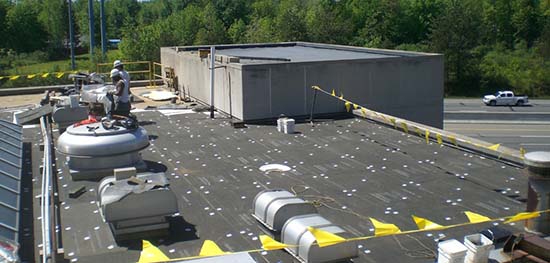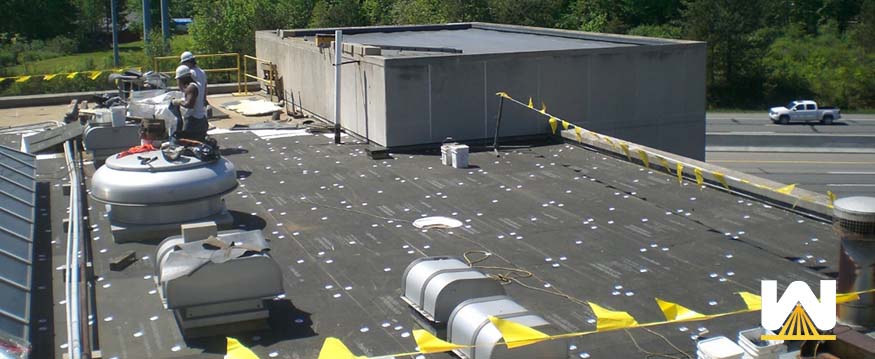Perhaps you’re collecting quotes for your roofing project and one contractor says “We need to install a coverboard before installing the new roofing system.”
You think “Is that necessary?” “Why is a coverboard needed?”, “Can I go without the coverboard?”
In this article we’re going to talk about:
What is a coverboard?
What’s the purpose of a coverboard?
A few scenarios where a coverboard is needed…and when it’s not
And just so you know, West Roofing Systems has been in commercial roofing since 1979. We use coverboards a lot, but only when it’s necessary to provide a well-performing roof.
Lastly, every piece of content is written in-house. We don’t hire freelancers or anyone external to write these. Every piece of content is reviewed and edited by a West Roofing salesman with more than 30 years in the industry.
Now let’s get started!
What is a coverboard?
A coverboard is a thin material that’s placed between the insulation and the top layer (membrane) of a roofing system.
The most common type of coverboard is polyiso, but there are others such as gypsum fiber, perlite, dens-deck, plywood, high-density wood fiber, and many others.
They all differ in R-value, performance, and cost.
Polyiso may be used for R-value purposes as it has an approximate R-value of 5.5 per inch of thickness.
Wood fiber is less costly than polyiso. It doesn’t have as much R-value, but if the only goal of the coverboard is to provide a nice substrate for TPO, EPDM, or Spray Foam to adhere to, then why choose a higher-cost coverboard?
Here’s an image of coverboards installed on a roof.

What’s the purpose of a coverboard?
The coverboard has three purposes:
To provide a new, clean, and adhered (mechanically or fully) substrate for a roofing system to attach to.
To provide R-value
To increase or decrease slope
Providing a clean substrate
When a new roof system is installed, you want to install it over something clean and dry. Some contractors will clean an existing membrane by power washing or spraying down a cleaner and then power washing.
If the existing membrane is in bad shape, it might be better to install a coverboard rather than clean it.
Either way, to install any roofing system, the existing membrane needs to be clean, dry, and attached to the insulation below. In some cases, this is best achieved by installing a coverboard.
To provide R-value
Each type of coverboard has its own costs, pros and cons, and R-value. A common reason to install a coverboard, such as polyiso, is because it adds R-value to your new roof.
Some roofing systems, such as TPO and EPDM, don’t provide much R-value (less than an R-1). But if you lay down 2 inches of polyiso (R-5.5 per inch of thickness), then your new roof would have roughly an R-11.
To increase or decrease slope
If your current roof has ponding water (water that doesn’t run off the roof within 24 hours) then you either have clogged drains, or the slope of the roof is off.
When you install a new roofing system, you can install what’s called a “tapered roof system”. This is where the slope is influenced by the insulation (or coverboard) as opposed to the roof membrane.
Single-ply roofs are flat.
If you just laid them down over your existing roof, the same ponding water issues would happen.
Coverboards come in different thickness levels. A contractor can lay down different thickness levels of a coverboard to direct water towards a drain or off the roof. Then a roofing system can be installed over the coverboard.
NOTE: You’ve probably never heard of a spray foam roof before (if not, here’s an intro). But with spray foam being fluid-applied, a contractor can influence the slope with a few more (or less) pulls of a trigger. This is incredibly easier and more cost-effective than laying down different thickness levels of a coverboard.
A few scenarios where a coverboard is needed, and when it’s not
When it’s needed:
- You want to install a new single-ply roof over an existing roof. The existing roof is in bad shape. For the new roof to adhere well, a coverboard needs to be installed first.
- You want to install a new single-ply roof over an existing roof with ponding water or sloping issues. A “tapered roof system” can be installed. Different coverboard thicknesses would be installed first before the new single-ply roof can be installed.
- You’d like to install a spray polyurethane foam roof, but the existing roof isn’t fully-adhered. An example of a “non-fully-adhered” roof is a single-ply roof that’s attached with screws and fasteners.
- If you’re trying to increase the R-value of your roof by installing any other roofing system besides spray polyurethane foam. TPO, EPDM, PVC, and metal have no significant R-value (less than R-1).
When a coverboard isn’t needed:
- You want to install a new single-ply roof over an existing single-ply roof. The existing roof is in good shape and there’s no ponding water. A contractor would clean the existing roof before installing the new roof.
- You want to install a spray foam roof over an existing gravel built-up or single-ply roof that’s fully-adhered. “Fully-adhered” means that every section/piece of a roof is attached to what’s beneath. An example would be an EPDM roof that was attached to the insulation below using an adhesive.
Conclusion
The last thing you want to do is spent money on a coverboard if it’s not needed. But if you need a coverboard, you at least want to know the purpose of it.
When you get a quote for your commercial building, make sure to ask the contractor what’s included in the scope of work.
If they include installing a coverboard, ask them why. And then allow them to show you the ponding water, the sloping issues, or the bad substrate that’s interfering with adhesion.
If they can’t justify the coverboard, you may want to look at using a different contractor.


